ARTIST MONOGRAPHS
|
|
in stock $29.95 Free Shipping UPS GROUND IN THE CONTINENTAL U.S. |
 Sophie Calle: Overshare
Sophie Calle: Overshare
Published by Walker Art Center.
Edited with text by Henriette Huldisch. Foreword by Mary Ceruti. Text by Eugenie Brinkeman, Aruna D’Souza, Courtenay Finn.
This volume accompanies the eponymous show at the Walker Art Center in Minneapolis, which is the first exhibition in North America to explore the range and depth of artist Sophie Calle’s practice across the past five decades. Through examples of major bodies of work as well as lesser-known pieces, the exhibition captures Calle’s astute probing into the human condition and reveals ways that her early work anticipated the rise of social media as a space to create and share oneself. The presentation features photography, video, installations and text-based works, highlighting the artist’s virtuosic use of different mediums to explore broadly recognizable and emotionally resonant themes. Organized into four thematic sections—“The Spy,” “The Protagonist,” “The End” and “The Beginning”—the book takes a new approach to some of Calle’s most acclaimed works including The Sleepers (1979) and Suite Vénitienne (1980), while also weaving in understudied works including Cash Machine (1991–2003) and Unfinished (2005). The catalog further explores this new examination of Calle's work with original writing by Henriette Huldisch, Eugenie Brinkeman, Aruna D’Souza and Courtenay Finn.
Sophie Calle (born 1953) is an internationally renowned artist whose controversial works often fuse conceptual art and Oulipo-like constraints, investigatory methods and the plundering of autobiography. The Whitechapel Gallery in London organized a retrospective in 2009, and her work has been shown at the Museum of Modern Art and the Whitney Museum of American Art, New York; the Carnegie Museum of Art, Pittsburgh; the Museum of Fine Arts, Boston; the Hayward Gallery and Serpentine, London; and the Museum of Contemporary Art, Chicago, among others. She lives and works in Paris.
PUBLISHER
Walker Art Center
BOOK FORMAT
Paperback, 9.5 x 11 in. / 200 pgs / 100 color / 100 bw.
PUBLISHING STATUS
Pub Date 11/12/2024
Active
DISTRIBUTION
D.A.P. Exclusive
Catalog: FALL 2024 p. 3
PRODUCT DETAILS
ISBN 9781935963301 TRADE
List Price: $50.00 CAD $71.00 GBP £45.00
AVAILABILITY
In stock
in stock $50.00 Free Shipping UPS GROUND IN THE CONTINENTAL U.S. |
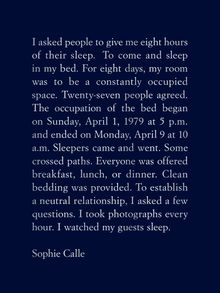 Sophie Calle: The Sleepers
Sophie Calle: The Sleepers
Published by Siglio.
Translation by Emma Ramadan.
In one of Sophie Calle’s first artistic experiments, she invited friends, acquaintances and strangers to sleep in her bed. Twenty-seven people agreed, among them a baker, a babysitter, an actor, a journalist, a seamstress, a trumpet player and three painters. Calle photographed them awake and asleep, secretly recording any private conversations once the door closed. She served each a meal, and, if they agreed, she subjected them to a questionnaire that probed their personal predilections, habits and dreams as well as their interpretations of the act of sleeping in her bed: a curiosity, a game, an artwork, or—as Calle intended it—a job. The result, comprising her first exhibition in 1979, was a grid of 198 photographs and short texts.
Unlike the original installation, this artist’s book version of The Sleepers contains not only all the photographs and captions but also her engrossing, novellalike narrative, untranslated until now. From the single, liminal mise-en-scène of her bedroom, Calle reports in text and photos, as if in real time, as sleepers arrive, talk, sleep, eat and leave. Their acute and sometimes startling, sometimes endearing particularities merge into something almost like an eight-day-long dream. Many seeds of Calle’s subsequent works are embedded in The Sleepers: her exacting and transgressive methods of investigation, her cultivation of intimacy and remove, and her unrelenting curiosity. In this work, as she observes the sleepers, they observe her too—with reciprocal candor. The Sleepers, clothbound and pillow-like, unfolds as it opens, inviting the reader to join the others in Calle’s bed.
PUBLISHER
Siglio
BOOK FORMAT
Clth, 6 x 8 in. / 304 pgs / 176 bw.
PUBLISHING STATUS
Pub Date 12/17/2024
Active
DISTRIBUTION
D.A.P. Exclusive
Catalog: FALL 2024 p. 33
PRODUCT DETAILS
ISBN 9781938221347 TRADE
List Price: $48.00 CAD $70.00 GBP £42.00
AVAILABILITY
In stock
in stock $48.00 Free Shipping UPS GROUND IN THE CONTINENTAL U.S. |
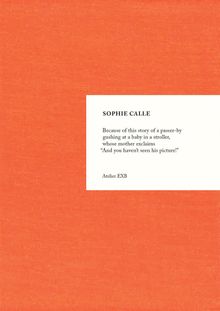 Sophie Calle: Because
Sophie Calle: Because
Published by Atelier EXB.
Words have always been central to the practice of French artist Sophie Calle (born 1953), who is known for her photographic work that often includes panels of text of her own writing. In this project, Calle conceives of the internal thought processes behind her art-making as stories to be told. It is with these stories—alongside the external stories of the moments preceding a click of a camera shutter—that Calle opens Because. The volume chronicles her reasons behind capturing particular moments in time, but the corresponding photos themselves are revealed only later, hidden in the interstices of the Japanese binding. In this process, Calle reverses the relationship of natural primacy between an image and the words that accompany it, instead calling our attention to the influence that the latter may have on our perception of a photograph.
The new revised edition of this classic artist’s book contains 39 loose photographs inserted between the pages, alongside text and other imagery by Calle. A beautiful object in its own right, it features Japanese binding and an iridescent orange cloth cover.
PUBLISHER
Atelier EXB
BOOK FORMAT
Hardcover, 6.75 x 9.5 in. / 168 pgs / 39 color.
PUBLISHING STATUS
Pub Date 12/3/2024
Active
DISTRIBUTION
D.A.P. Exclusive
Catalog: FALL 2024 p. 33
PRODUCT DETAILS
ISBN 9782365114097 SDNR40
List Price: $55.00 CAD $79.00
AVAILABILITY
In stock
in stock $55.00 Free Shipping UPS GROUND IN THE CONTINENTAL U.S. |
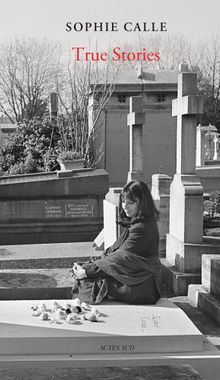 Sophie Calle: True Stories
Sophie Calle: True Stories
66 Short Stories: New Edition
Published by Actes Sud.
First published in 1994 and regularly reissued and expanded since, this new edition of True Stories returns with three new stories. Calle’s projects have frequently drawn on episodes from her own life, but this book—part visual memoir, part meditation on the resonances of photographs and belongings—is as close as she has come to producing an autobiography, albeit one highly poetical and fragmentary, as is characteristic of her work. The tales—never longer than a page—are by turns lighthearted, humorous, serious, dramatic or cruel. Each is accompanied by an image; each offers a fragment of life. Calle herself is the author, narrator and protagonist of her stories and photography. Her words are somber, chosen precisely and carefully. She offers up her own memories—childhood, marriage, sex and death—with brilliant humor, insight and pleasure. By turns serious, hilarious, dramatic or cruel, these real-life stories represent a form of work in progress recounting fragments of her life.
Sophie Calle (born 1953) is an internationally renowned artist whose controversial works often fuse conceptual art and Oulipo-like constraints, investigatory methods and the plundering of autobiography. Her work has been shown at the Museum of Modern Art, New York, the Whitney Museum of American Art, the Carnegie Museum of Art, the Museum of Fine Arts, Boston, the Hayward Gallery and the Museum of Contemporary Art, Chicago, among others. She lives and works in Paris.
PUBLISHER
Actes Sud
BOOK FORMAT
Hardcover, 4 x 7.5 in. / 152 pgs / 28 color / 36 bw.
PUBLISHING STATUS
Pub Date 4/9/2024
Active
DISTRIBUTION
D.A.P. Exclusive
Catalog: SPRING 2024 p. 32
PRODUCT DETAILS
ISBN 9782330182465 TRADE
List Price: $22.00 CAD $32.00 GBP £18.50
AVAILABILITY
In stock
in stock $22.00 Free Shipping UPS GROUND IN THE CONTINENTAL U.S. |
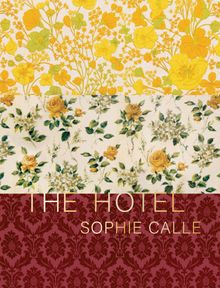 Sophie Calle: The Hotel
Sophie Calle: The Hotel
Published by Siglio.
In 1981 Sophie Calle took a job as a chambermaid for the Hotel C in Venice, Italy. Stashing her camera and tape recorder in her mop bucket, she not only cleans and tidies, but sorts through the evidence of the hotel guests' lives. Assigned 12 rooms on the fourth floor, she surveys the state of the guests' bedding, their books, newspapers and postcards, perfumes and cologne, traveling clothes and costumes for Carnival. She methodically photographs the contents of closets and suitcases, examining the detritus in the rubbish bin and the toiletries arranged on the washbasin. She discovers their birth dates and blood types, diary entries, letters from and photographs of lovers and family. She eavesdrops on arguments and love-making. She retrieves a pair of shoes from the wastebasket and takes two chocolates from a neglected box of sweets, while leaving behind stashes of money, pills and jewelry. Her thievery is the eye of the camera, observing the details that were not meant for her, or us, to see.
The Hotel now manifests as a book for the first time in English (it was previously included in the book Double Game). Collaborating with the artist on a new design that features enhanced and larger photographs, and pays specific attention to the beauty of the book as an object, Siglio is releasing its third book authored by Calle, after The Address Book (2012) and Suite Vénitienne (2015).
Sophie Calle (born 1953) is an internationally renowned artist whose controversial works often fuse conceptual art and Oulipo-like constraints, investigatory methods and the plundering of autobiography. The Whitechapel Gallery in London organized a retrospective in 2009, and her work has been shown at the Museum of Modern Art and the Whitney Museum of American Art, New York; the Carnegie Museum of Art, Pittsburgh; the Museum of Fine Arts, Boston; the Hayward Gallery and Serpentine, London; and the Museum of Contemporary Art, Chicago, among others. She lives and works in Paris.
PUBLISHER
Siglio
BOOK FORMAT
Clth, 6 x 8 in. / 224 pgs / 12 color / 180 bw.
PUBLISHING STATUS
Pub Date 12/7/2021
Active
DISTRIBUTION
D.A.P. Exclusive
Catalog: FALL 2021 p. 18
PRODUCT DETAILS
ISBN 9781938221293 TRADE
List Price: $39.95 CAD $49.95 GBP £31.99
AVAILABILITY
In stock
in stock $39.95 Free Shipping UPS GROUND IN THE CONTINENTAL U.S. |
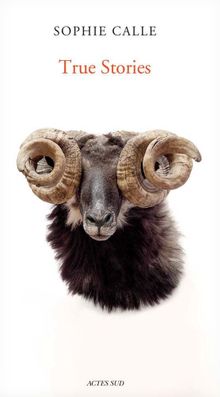 Sophie Calle: True Stories
Sophie Calle: True Stories
Sixth Edition
Published by Actes Sud.
First published in French in 1994, quickly acclaimed as a photobook classic and since republished and enhanced, True Stories returns for the sixth time, gathering a series of short autobiographical texts and photos by acclaimed French artist Sophie Calle, this time with four new tales. Calle's projects have frequently drawn on episodes from her own life, but this book—part visual memoir, part meditation on the resonances of photographs and belongings—is as close as she has come to producing an autobiography, albeit one highly poetical and fragmentary, as is characteristic of her work. The tales—never longer than a page—are by turns lighthearted, humorous, serious, dramatic or cruel. Each is accompanied by an image; each offers a fragment of life.
The slim, portable volume is divided into sections: the first is composed of various reflections on objects such as a shoe, a postcard or "the breasts"; the second, "The Husband," of recollections of episodes from Calle's first marriage; and the third gathers a variety of autobiographical recollections. Calle herself is the author, narrator and protagonist of her stories and photography; her words are somber, chosen precisely and carefully. One of the 21st century's foremost artists, Calle here offers up her own story—childhood, marriage, sex, death—with brilliant humor, insight and pleasure.
PUBLISHER
Actes Sud
BOOK FORMAT
Hardcover, 4 x 7.5 in. / 112 pgs / 51 color.
PUBLISHING STATUS
Pub Date 5/22/2018
Out of print
DISTRIBUTION
D.A.P. Exclusive
Catalog: FALL 2018 p. 40
PRODUCT DETAILS
ISBN 9782330093037 TRADE
List Price: $20.00 CAD $27.95 GBP £17.00
AVAILABILITY
Not available
STATUS: Out of print | 00/00/00 For assistance locating a copy, please see our list of recommended out of print specialists |
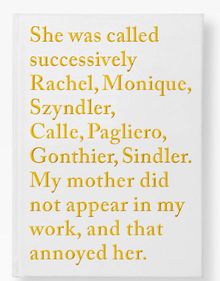 Sophie Calle: Rachel Monique
Sophie Calle: Rachel Monique
Published by Editions Xavier Barral.
Text by Sophie Calle, Monique Szyndler.
“She was called successively Rachel, Monique, Szyndler, Calle, Pagliero, Gonthier, Sindler,” reads the first lines of Sophie Calle: Rachel Monique, embroidered on the cover. “My mother liked people to talk about her. Her life did not appear in my work, and that annoyed her. When I set up my camera at the bottom of the bed in which she lay dying—fearing that she would pass away in my absence, whereas I wanted to be present and hear her last words—she exclaimed, ‘Finally.’”
Sophie Calle: Rachel Monique tells the story of Monique Szyndler, Sophie Calle’s mother who died in 2007, through diary excerpts and photographs selected by the artist from family albums. Described as “haunting” and “a mystery novel that tirelessly searches for a missing person,” the Rachel Monique project honors a daughter’s complicated relationship with her mother and the artist’s deeply felt grief.
This volume, presenting Calle’s installation of Rachel Monique at the Palais de Tokyo, was designed in close collaboration with the artist. The cover text is embroidered to create a precious object, and all of the texts relating to the installation are beautifully embossed. Sophie Calle: Rachel Monique is a highly personal and moving book, intimate and universal in its expressions of mourning and memory.
Sophie Calle (born 1953) creates works exploring the tensions between the observed, the reported, the secret and the unsaid. She has mounted solo shows at major museums across the world and represented France at the Venice Biennale in 2007, where her film of her mother’s deathbed, Couldn’t Capture Death, premiered.
PUBLISHER
Editions Xavier Barral
BOOK FORMAT
Clth, 6.75 x 9.5 in. / 208 pgs / 38 color / 57 bw.
PUBLISHING STATUS
Pub Date 4/25/2017
Active
DISTRIBUTION
D.A.P. Exclusive
Catalog: SPRING 2017 p. 50
PRODUCT DETAILS
ISBN 9782365111171 TRADE
List Price: $75.00 CAD $99.00
AVAILABILITY
Out of stock
STATUS: Out of stock Temporarily out of stock pending additional inventory. |
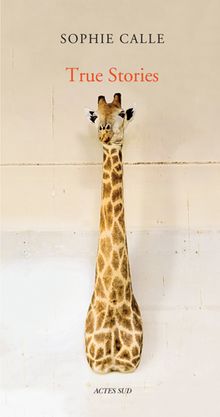 Sophie Calle: True Stories
Sophie Calle: True Stories
Fifth Edition
Published by Actes Sud.
First published in French in 1994, quickly acclaimed as a photobook classic and since republished and enhanced, True Stories returns for the fifth time, gathering a series of short autobiographical texts and photos by acclaimed French artist Sophie Calle, this time with four new tales. Calle’s projects have frequently drawn on episodes from her own life, but this book--part visual memoir, part meditation on the resonances of photographs and belongings--is as close as she has come to producing an autobiography, albeit one highly poetical and fragmentary, as is characteristic of her work. The tales--never longer than a page--are by turns lighthearted, humorous, serious, dramatic or cruel. Each is accompanied by an image; each offers a fragment of life.
The slim, portable volume is divided into sections: the first is composed of various reflections on objects such as a shoe, a postcard or “the breasts”; the second, “The Husband,” of recollections of episodes from Calle’s first marriage; and the third gathers a variety of autobiographical recollections. Calle herself is the author, narrator and protagonist of her stories and photography; her words are somber, chosen precisely and carefully. One of the 21st century’s foremost artists, Calle here offers up her own story--childhood, marriage, sex, death--with brilliant humor, insight and pleasure.
Sophie Calle (born 1953) creates controversial works exploring the tensions between the observed, the reported, the secret and the unsaid. She has mounted solo shows at major museums across the world and represented France at the Venice Biennale in 2007.
PUBLISHER
Actes Sud
BOOK FORMAT
Hardcover, 4 x 7.5 in. / 112 pgs / 51 color.
PUBLISHING STATUS
Pub Date 8/23/2016
Out of print
DISTRIBUTION
D.A.P. Exclusive
Catalog: FALL 2016 p. 73
PRODUCT DETAILS
ISBN 9782330060404 TRADE
List Price: $20.00 CAD $27.95
AVAILABILITY
Not available
STATUS: Out of print | 00/00/00 For assistance locating a copy, please see our list of recommended out of print specialists |
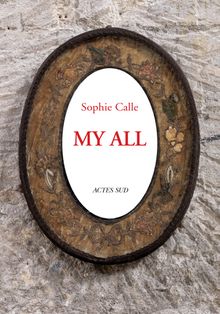 Sophie Calle: My All
Sophie Calle: My All
Published by Actes Sud.
PUBLISHER
Actes Sud
BOOK FORMAT
Hardcover, 4 x 6 in. / 50 pgs / illustrated throughout.
PUBLISHING STATUS
Pub Date 3/22/2016
Out of print
DISTRIBUTION
D.A.P. Exclusive
Catalog: SPRING 2016 p. 139
PRODUCT DETAILS
ISBN 9782330053697 SDNR50
List Price: $35.00 CAD $47.50 GBP £30.00
AVAILABILITY
Not available
STATUS: Out of print | 00/00/00 For assistance locating a copy, please see our list of recommended out of print specialists |
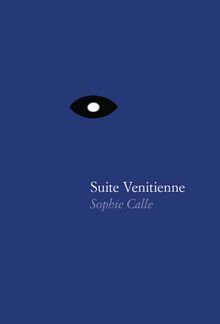 Sophie Calle: Suite Vénitienne
Sophie Calle: Suite Vénitienne
Published by Siglio.
Sophie Calle (born 1953) is an internationally renowned artist whose controversial works explore the tensions between the observed, the reported, the secret and the unsaid. She has mounted solo shows at major museums around the world and represented France at the Venice Biennale in 2007. Her most recent US exhibition was the acclaimed Rachel, Monique at the Episcopal Church of the Heavenly Rest in Manhattan in 2014.
PUBLISHER
Siglio
BOOK FORMAT
Hardcover, 5.5 x 8 in. / 96 pgs / 4 color / 56 bw.
PUBLISHING STATUS
Pub Date 5/26/2015
Active
DISTRIBUTION
D.A.P. Exclusive
Catalog: SPRING 2015 p. 45
PRODUCT DETAILS
ISBN 9781938221095 TRADE
List Price: $34.95 CAD $45.95 GBP £30.00
AVAILABILITY
In stock
in stock $34.95 Free Shipping UPS GROUND IN THE CONTINENTAL U.S. |
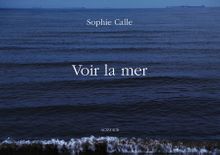 Sophie Calle: Voir la mer
Sophie Calle: Voir la mer
Published by Actes Sud.
PUBLISHER
Actes Sud
BOOK FORMAT
Hardcover, 8.25 x 5.5 in. / 64 pgs / 30 color.
PUBLISHING STATUS
Pub Date 2/28/2014
Active
DISTRIBUTION
D.A.P. Exclusive
Catalog: FALL 2013 p. 100
PRODUCT DETAILS
ISBN 9782330016166 TRADE
List Price: $35.00 CAD $47.50 GBP £29.00
AVAILABILITY
Out of stock
STATUS: Out of stock Temporarily out of stock pending additional inventory. |
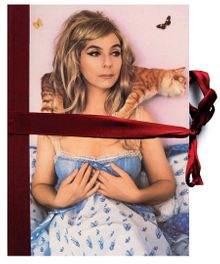 Sophie Calle: Double Game
Sophie Calle: Double Game
Published by Violette Editions.
With the participation of Paul Auster.
PUBLISHER
Violette Editions
BOOK FORMAT
Hardcover, 5.5 x 7.5 in. / 296 pgs / 85 color / 373 bw.
PUBLISHING STATUS
Pub Date 11/30/2013
Out of print
DISTRIBUTION
D.A.P. Exclusive
Catalog: FALL 2013 p. 74
PRODUCT DETAILS
ISBN 9781900828284 TRADE
List Price: $39.95 CAD $53.95
AVAILABILITY
Not available
STATUS: Out of print | 00/00/00 For assistance locating a copy, please see our list of recommended out of print specialists |
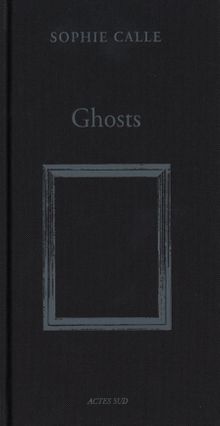 Sophie Calle: Ghosts
Sophie Calle: Ghosts
Published by Actes Sud.
Text by Sophie Calle.
PUBLISHER
Actes Sud
BOOK FORMAT
Clth, 4 x 7.5 in. / 176 pgs / 70 color.
PUBLISHING STATUS
Pub Date 9/30/2013
Out of print
DISTRIBUTION
D.A.P. Exclusive
Catalog: FALL 2013 p. 100
PRODUCT DETAILS
ISBN 9782330020149 TRADE
List Price: $30.00 CAD $40.00 GBP £26.00
AVAILABILITY
Not available
STATUS: Out of print | 00/00/00 For assistance locating a copy, please see our list of recommended out of print specialists |
 Sophie Calle: Ghosts
Sophie Calle: Ghosts
Published by Actes Sud.
Text by Sophie Calle.
PUBLISHER
Actes Sud
BOOK FORMAT
Clth, 4 x 7.5 in. / 176 pgs / 70 color.
PUBLISHING STATUS
Pub Date 9/30/2013
Out of print
DISTRIBUTION
D.A.P. Exclusive
Catalog: FALL 2013 p. 100
PRODUCT DETAILS
ISBN 9782330020149 TRADE
List Price: $30.00 CAD $40.00 GBP £26.00
AVAILABILITY
Not available
STATUS: Out of print | 00/00/00 For assistance locating a copy, please see our list of recommended out of print specialists |
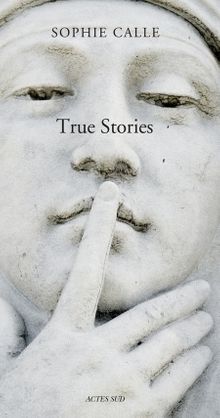 Sophie Calle: True Stories
Sophie Calle: True Stories
Published by Actes Sud.
Text by Sophie Calle.
PUBLISHER
Actes Sud
BOOK FORMAT
Hardcover, 4 x 7.75 in. / 104 pgs / 13 color / 34 bw.
PUBLISHING STATUS
Pub Date 10/31/2013
Out of print
DISTRIBUTION
D.A.P. Exclusive
Catalog: SPRING 2014 p. 108
PRODUCT DETAILS
ISBN 9782330023416 TRADE
List Price: $24.95 CAD $27.50
AVAILABILITY
Not available
STATUS: Out of print | 00/00/00 For assistance locating a copy, please see our list of recommended out of print specialists |
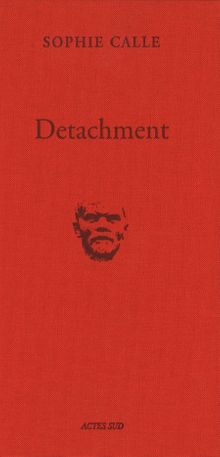 Sophie Calle: Detachment
Sophie Calle: Detachment
Published by Actes Sud.
Text by Sophie Calle.
PUBLISHER
Actes Sud
BOOK FORMAT
Clth, 4 x 7.5 in. / 72 pgs / 22 color.
PUBLISHING STATUS
Pub Date 9/30/2013
Out of stock indefinitely
DISTRIBUTION
D.A.P. Exclusive
Catalog: FALL 2013 p. 100
PRODUCT DETAILS
ISBN 9782330019808 TRADE
List Price: $25.00 CAD $34.50 GBP £22.00
AVAILABILITY
Not available
STATUS: Out of stock indefinitely. |
 Sophie Calle: The Address Book
Sophie Calle: The Address Book
Published by Siglio.
PUBLISHER
Siglio
BOOK FORMAT
Hardcover, 5.25 x 7.5 in. / 104 pgs / 2 color / 26 bw.
PUBLISHING STATUS
Pub Date 9/30/2012
Active
DISTRIBUTION
D.A.P. Exclusive
Catalog: FALL 2012 p. 60
PRODUCT DETAILS
ISBN 9780979956294 TRADE
List Price: $29.95 CAD $39.95 GBP £27.00
AVAILABILITY
In stock
in stock $29.95 Free Shipping UPS GROUND IN THE CONTINENTAL U.S. |
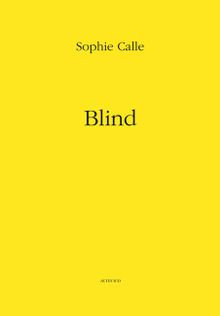 Sophie Calle: Blind
Sophie Calle: Blind
Published by Actes Sud.
PUBLISHER
Actes Sud
BOOK FORMAT
Hardcover, 8.25 x 11.75 in. / 103 pgs / 90 color.
PUBLISHING STATUS
Pub Date 4/30/2012
Out of print
DISTRIBUTION
D.A.P. Exclusive
Catalog: SPRING 2012 p. 61
PRODUCT DETAILS
ISBN 9782330000585 TRADE
List Price: $50.00 CAD $67.50 GBP £44.00
AVAILABILITY
Not available
STATUS: Out of print | 00/00/00 For assistance locating a copy, please see our list of recommended out of print specialists |
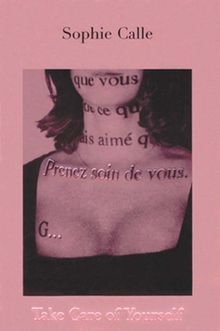 Sophie Calle: Take Care of Yourself
Sophie Calle: Take Care of Yourself
Published by Dis Voir/Actes Sud.
Text by Sophie Calle.
PUBLISHER
Dis Voir/Actes Sud
BOOK FORMAT
Hardback, 8.25 x 12 in. / 424 pgs / 108 color / DVD (PAL).
PUBLISHING STATUS
Pub Date 12/15/2007
Active
DISTRIBUTION
D.A.P. Exclusive
Catalog: SPRING 2008 p. 61
PRODUCT DETAILS
ISBN 9782742768936 TRADE
List Price: $125.00 CAD $170.00 GBP £105.00
AVAILABILITY
Out of stock
STATUS: Out of stock Temporarily out of stock pending additional inventory. |
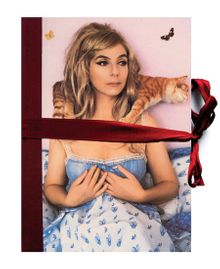 Sophie Calle: Double Game
Sophie Calle: Double Game
Published by D.A.P./Violette Editions.
With the participation of Paul Auster.
This new edition, published to coincide with the 2007 Venice Biennale, at which Calle represented France, is identical in content to the first, and reprises all of the cherished qualities of the original in a smaller hardback format--including the signature ribbon around its middle.
The story begins with Maria, the fictional character in Paul Auster's novel, Leviathan. Most of Maria's "works" are, in fact, based on those of Sophie Calle. The first section of Double Game takes us through the few original works by Maria that Sophie makes her own, shown both in their fictional context and illustrated by Calle's actual reproduction of them. The second section takes the story further into the heart of Calle's world, with a series of Calle's seminal narrative and abstract works in text and images that were appropriated by Maria in Leviathan. The third section of the book takes the dialogue directly to Maria's inventor, Paul Auster, who in turn takes Calle as his subject, inventing for her the Gotham Handbook, which offers "Personal Instructions for SC on How to Improve Life in New York City (Because she asked...)."
PUBLISHER
D.A.P./Violette Editions
BOOK FORMAT
Hardback, 5.5 x 7.5 in. / 296 pgs / 85 color / 373 bw
PUBLISHING STATUS
Pub Date 9/1/2007
Out of print
DISTRIBUTION
D.A.P. Exclusive
Catalog: FALL 2007 p. 169
PRODUCT DETAILS
ISBN 9781933045696 TRADE
List Price: $39.95 CAD $50.00
AVAILABILITY
Not available
STATUS: Out of print | 00/00/00 For assistance locating a copy, please see our list of recommended out of print specialists |
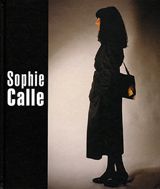 Sophie Calle
Sophie Calle
Published by Walther König, Köln.
Artwork by Sophie Calle. Edited by Inka Schube. Text by Knut Ebeling, Christine Karallus, Elisabeth Strowick.
PUBLISHER
Walther König, Köln
BOOK FORMAT
Hardcover, 9 x 10.5 in. / 175 pgs / 130 color / illustrated throughout
PUBLISHING STATUS
Pub Date 2/2/2003
Out of print
DISTRIBUTION
D.A.P. Exclusive
Catalog: SPRING 2003
PRODUCT DETAILS
ISBN 9783883755922 SDNR30
List Price: $45.00 CAD $55.00
AVAILABILITY
Not available
STATUS: Out of print | 6/1/2005 For assistance locating a copy, please see our list of recommended out of print specialists |
 Sophie Calle: Double Game And The Gotham Handbook
Sophie Calle: Double Game And The Gotham Handbook
Published by Violette Editions.
Artwork by Sophie Calle. Text by Paul Auster.
PUBLISHER
Violette Editions
BOOK FORMAT
8 x 11.4 in. / 296 pgs / 85 color / 373 bw.
PUBLISHING STATUS
Pub Date 1/2/2000
Out of print
DISTRIBUTION
D.A.P. Exclusive
Catalog: FALL 1998
PRODUCT DETAILS
ISBN 9781900828062 TRADE
List Price: $125.00 CAD $150.00
AVAILABILITY
Not available
STATUS: Out of print | 4/1/2008 For assistance locating a copy, please see our list of recommended out of print specialists |

